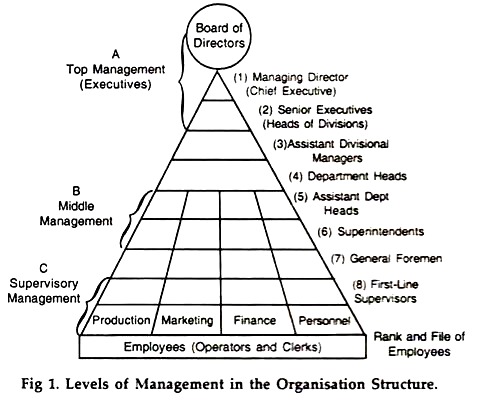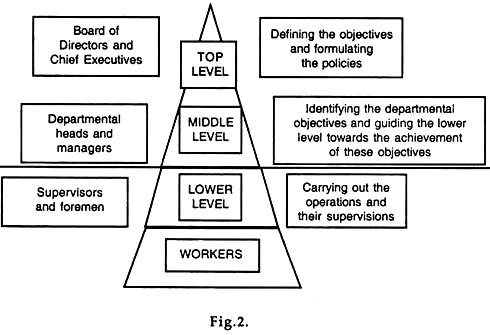After reading this article you will learn about Levels of Management:- 1. Subject-Matter of Levels of Management 2. Comments on Levels of Management 3. Types.
Subject-Matter of Levels of Management:
The organisational pyramid gives us a vertical hierarchy (dimension). Delegations of authority based on span of control creates multiple levels of management or organisation. Narrow span of control creates more levels in the organisational hierarchy and the numerous levels in the hierarchy are centralised, or closely controlled.
We also have a tall organisation pyramid when there are multiple levels of management. On the other hand, when we have a wide span of control, there are fewer levels of management and the organisation is decentralised, or loosely controlled. Wide span of control also gives us a flat organisation pyramid.
Comments on Levels of Management:
(1) Each level of management is an integral part of the chain of command and as such it acts as the channel for transmission of authority to the succeeding lower levels of the management. We have downward flow of authority.
(2) Each level of management also serves as a primary vehicle for formal communication, e.g., orders, instructions, explanations, requests for information, etc. Similarly it can also act as a channel for upward communication of reports on results achieved, complaints, grievances, protests and reactions in the form of a feedback of information.
(3) Multiple levels of management give us a scalar chain or vertical hierarchy which is dictated by the principle of unity of command linking all members of the organisation from top to bottom.
(4) Power and authority are delegated downwards, beginning at the top, from each manager to his subordinates. Each position has a complete sphere of operation.
(5) Lowest-level positions are grouped together and assigned to the next higher office. In turn, each managerial position is under control of a higher one. Each manager is accountable to his superior on the next higher level for his performance as well as for his subordinate’s actions and decisions. All are accountable to the highest official, the chief executive, at the top management hierarchy.
(6) Too many levels of management are not desirable.
The process of delegation and relegation continues until all work, both administrative and operative, is assigned to employees having time and ability to perform it well. Each time an executive delegates, he forges a new link in the chain of command.
The bottom man has his boss, who in turn has his boss, and so on up-to the chief executive. We have given three broad levels of management. In practice, we may have many levels of management even up-to ten or more. The span of control and the size of the business are the two important factors in determining the levels of management in the organisation structure.
The shorter the span of control, the longer will be the chain of command and we shall have a tall organisation structure with multiple levels of management. But it will create difficulty of proper co-ordination as well as effective communication which are the sine qua non of good management.
In a huge and complex organisation, we may have many levels in the organisation pyramid and each succeeding level represents decreasing authority and status. The practice of delegation of authority creates a chain of command (Scalar principle).
The government of a large corporation has a representative type of management. At the top are thousands of shareholders who are the owners but not the managers of the corporation.
Types of Levels of Management:
Different managers perform different types of duties. Some managers decide about the objectives of the business as a whole; some managers perform functions to achieve these objectives in different departments, like production, sales, etc., and some of the managers are concerned with the supervision of day-do-day activities of workers.
Managers performing different types of duties may, thus, be divided into three categories:
1. Top-Level Management
2. Middle-Level Management
3. Lower-Level Management
1. Top Management:
The board appoints the chief executive, e.g., president or managing director or general manager who is delegated the task of running the entire business. We have other few senior executives, e.g., vice-presidents, deputy general managers or divisional managers to assist the chief executive.
The small body of executives, e.g., managing director and a few senior executives constitutes the top management in charge of all managerial functions and powers. The chief executive, i.e., managing Director or General Manager, operates the business in order to accomplish objectives set by the governing board. He is accountable to the board and enjoys all necessary management powers.
He is the head of the organisation. Since the chief executive cannot do all the work himself, he delegates large blocks of duties to senior executives or divisional managers. The senior executives are the deputies of the chief executive and they are the functional heads responsible to co-ordinate activities in their areas to attain the company objectives. They are the top managers working under the chief executive.
Functions of Top Management:
(a) Determination of goals or objectives.
(b) Policy-framing.
(c) Formation of plans to carry out objectives and policies.
(d) Building up an Organisation a framework for executing plans.
(e) Mobilisation of resources to implement the plans 5 M’s.
(f) Motivating personnel for effective performance through appropriate leadership.
(g) Co-ordination and communication.
(h) Controlling operations to ensure realisation of set goals or objectives.
2. Middle Management:
Similarly, divisional managers in turn re-delegate to their subordinates, e. g., departmental managers. Then we have a large group of middle managers consisting of heads of departments and superintendents. They are the assistants to senior executives and act as their deputies.
Middle management includes heads of specialised sections. Middle managers are also called junior executives or administrators. Co-ordination is the central problem of management and the middle management provides the key people in achieving effective co-ordination upward, downward and also sideways in the managerial hierarchy.
3. Lower Management:
At the bottom of the managerial hierarchy, we have the lower management group called supervisory management consisting of supervisors or foremen and office superintendents. It is the lower management group who puts the plans of management into effective action, allocating individual work and seeing that it is accomplished as per schedule.
It is a large group (of first line supervisors and these managers at the lower level are directly in charge of (he operatives or employees.
The diagram below shows that the top level management includes Board of Directors and the Chief Executive. The chief executive may have the designation of Chairman, Managing Director, President, or General Manager.
This level determines the objectives of the business as a whole and lays down policies to achieve these objectives (making of policy means providing guidelines for actions and decision). The top management also exercise, in overall control over the organisation.
The middle-level management includes heads of various departments, e.g, production, sales, etc., and other departmental managers. Sometimes senior departmental heads are included in the top management team.
The objectives of the business as a whole are translated into departmental objectives for the middle level management. The heads of the departments then issue instructions to subordinates so as to achieve these objectives. Middle-level managers are particularly concerned with the activities of their respective departments.
The lower-level management consists of foremen and supervisors. When the work is assigned to workers, then these people see that the work is carried out properly and at the right time. So their functions are supervisory in nature. These three levels of management taken together form the ‘hierarchy of management’. It indicates the ranks and positions of managers in the hierarchy.
It shows that the middle-level management is subordinate to the top-level and that the lower level is subordinate to the middle-level management. Carefully see the figure shown above once again. You will see that the number of people at each level increases as one moves from top to bottom.
Workers including crafts persons, manual labourers, engineers, scientists, etc., form the bulk of the organisation membership. Within the managerial ranks, the number of managers at each level decreases as one moves from lower-level to top-level management. At the top of the organisation, there is usually one person.

